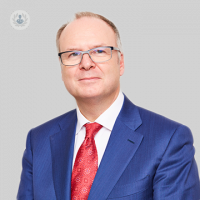All you need to know about blepharoplasty
Written in association with:A blepharoplasty, otherwise known as eyelid surgery, is an operation to remove excess skin, muscle and fatty tissue from the upper and/or lower eyelids. In this article below, esteemed consultant craniofacial plastic surgeon, Mr Simon Eccles, reveals whether or not droopy eyelids can be corrected with blepharoplasty surgery.

Can droopy eyelids be corrected with blepharoplasty surgery?
Yes they can. Droopiness of the upper eyelids causes ‘hooding’, where the vision can be partly obstructed by excess skin in the upper eyelids. This can affect vision when driving and at work. It can make you look tired, and can be very ageing. The surgery to remove skin from the upper lids will treat the droopiness.
Sometimes, it is not just excess tissue that causes droopiness, but the upper eyelid itself sits in a lower position. This is called ptosis. This can be congenital (which means you were born with this condition), or acquired. It can be an age-related change. This can also be corrected but requires a different procedure.
How long does a blepharoplasty procedure take?
Blepharoplasty surgery to the upper lids takes around 90 minutes. This is carried out under a local anaesthetic and at Mr Eccles’ practice. Surgery to the lower lids takes a little longer and may require a general anaesthetic.
What is involved in eye lift surgery?
At the initial consultation, Mr Simon Eccles would find out what your concerns are, and what you do not like about your eyes. If you have photos when you were younger this would be very helpful.
Mr Eccles will take a full medical history, particularly of any eye conditions such as glaucoma or dry eyes, before examining you. In the examination he will look at your eyes, the laxity of the lids and the quality of the skin around your eyes. He will also examine your brow position. Following this, some clinical photographs would be taken.
After this initial consultation, he would write to you detailing this examination and explaining the surgery. The surgery to the upper lids involves carefully marking out the excess tissue on the lids. Local anaesthetic is gently injected into the lids. The excess tissue is then excised. Haemostats are then used carefully to control bleeding and the wounds sutured together. Paper strips are placed over the sutures.
You will then be placed in a quiet recovery room for half an hour with cool packs on your eyes. After this the nurses and Mr Eccles will check you are ok, before letting you go home. The next day you will get a phone call from my nurse. Mr Eccles will see you about a week after surgery and the stitches will be removed. The final result will take another couple of weeks, to allow for the bruising and residual swelling to settle.
What are the possible complications of eye lift surgery?
The complications of surgery include bruising and discomfort in the first few days. These will settle and Mr Eccles and his team are available if issues arise. In the longer term, slight asymmetry and tender scars can also occur, as well as swelling of the conjunctiva (the tissue lining the surface of the eyeball) but these are very rare.
The most inopportune complication to inform patients of is changes to the vision and loss of vision. This is very rare with an incidence of one in 10,000.
What is the recovery time of blepharoplasty?
In upper lid blepharoplasty, the recovery time is fairly rapid, at 7 to 10 days. After the first few days, you would be able to go out, although you may want to wear dark glasses to protect their eyes. Close work and computer work should be curtailed for a few weeks. Occasionally, the dry eye symptoms can last a little longer, and you will be given drops and ointment to use until this settles.
For lower lids, the recovery time is a little longer, and the swelling can persist for a couple of weeks. If you are having upper and lower lid blepharoplasties, the healing time can be a little longer - up to two to three weeks.
To book an appointment with Mr Simon Eccles, simply visit his Top Doctors profile today.


